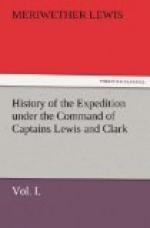Friday 24. The water in the kettles froze one eighth of an inch during the night; the ice appears along the margin of the river, and the cottonwood trees which have lost nearly all their leaves by the frost, are putting forth other buds. We proceeded with the line principally till about nine o’clock, when a fine breeze sprung up from the S.E. and enabled us to sail very well, notwithstanding the rapidity of the current. At one mile and a half is a large creek thirty yards wide, and containing some water which it empties on the north side, over a gravelly bed, intermixed with some stone. A man who was sent up to explore the country returned in the evening, after having gone ten miles directly towards the ridge of mountains to the north, which is the source of this as well as of Teapot creek. The air of these highlands is so pure, that objects appear much nearer than they really are, so that although our man went ten miles without thinking himself by any means half way to the mountains, they do not from the river appear more than fifteen miles distant; this stream we called Northmountain creek. Two and a half miles higher is a creek on the south which is fifteen yards wide, but without any water, and to which we gave the name of Littledog creek, from a village of burrowing squirrels opposite to its entrance, that being the name given by the French watermen to those animals. Three miles from this a small creek enters on the north, five beyond which is an island a quarter of a mile in length, and two miles further a small river: this falls in on the south, is forty yards wide, and discharges a handsome stream of water; its bed rocky with gravel and sand, and the banks high: we called it Southmountain creek, as from its direction it seemed to rise in a range of mountains about fifty or sixty miles to the S.W. of its entrance. The low grounds are narrow and without timber; the country high and broken; a large portion of black rock, and brown sandy rock appears in the face of the hills, the tops of which are covered with scattered pine, spruce and dwarf cedar: the soil is generally poor, sandy near the tops of the hills, and nowhere producing much grass, the low grounds being covered with little else than the hysop, or southern wood, and the pulpy-leafed thorn. Game is more scarce, particularly beaver, of which we have seen but few for several days, and the abundance or scarcity of which seems to depend on the greater or less quantity of timber. At twenty-four and a half miles we reached a point of woodland on the south, where we observed that the trees had no leaves, and encamped for the night. The high country through which we have passed for some days, and where we now are, we suppose to be a continuation of what the French traders called the Cote Noire or Black hills. The country thus denominated consists of high broken irregular hills and short chains of mountains; sometimes one hundred and twenty miles in width, sometimes narrower,




